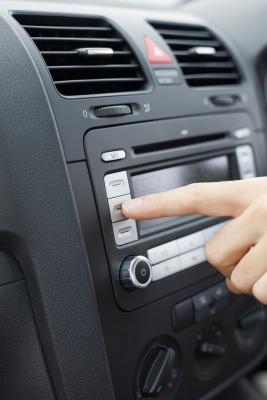
Ignition noise filters function as RFI, or radio frequency interference, suppressors. When voltage runs through an electrical system -- like an alternator, coil, distributor cap or plug wires -- stray voltage can leak through the insulation, or at a point where the electrical transmission leaks to the air and gets picked up by the radio antenna. Ignition noise filters trap and absorb extraneous voltage leaks, so the signals do not interfere with radio reception.
An ignition noise trap filter, commonly used in vehicle radios, traps excessive electrical energy noise from the engine components, so it does not travel through the power source into the radio circuitry. It uses a capacitor to bridge between the hot (active) wire and a neutral wire. Trap noise filters normally trap and absorb low frequencies sounds, as in the 60Hz range. Some higher frequencies can get through the noise trap filter, but these types of noise filters can usually handle any current load.
Alternators, which are a type of inductive motor, use contact brushes to generate an electric field. As the brushes transfer electricity to the alternator rotor, they sometimes lose contact and generate a large frequency spike in the power line. This noise or interference can be heard through the radio speakers as a whine that increases in tone and amplitude as the engine increases in rpm (speed). Noise filters are typically spliced into the alternator hot wire and ground, to suppress the electrical disturbance.
Vehicle spark plugs, coils, points and plug wires consist of the secondary wiring system on a vehicle, and can be responsible for popping or crackling noises in a running engine. The fault usually lies with torn or cracked insulation in the plug wires, or a cracked or dislodged spark plug boot. Plug wires and spark plugs that are of non-resistor type design, also contribute to the electrical disturbance that travels through the radio speakers. A buzzing sound, rather than a popping sound, usually originates from the ignition points, coil or distributor, and can be effectively repaired by the change-out of the points condenser.
Bolt-on type noise filters look like small metal canisters, typically equipped with two wires of different colors. Some have a red and blue wire or a red and black wire. They usually connect, or splice, into the main power source that leads to the radio by either a spade (push-on) connector, or come equipped with eyelets that bolt onto the radio chassis or near it. They capture any stray EMF (electromagnetic field) coming from a power source, before it reaches the radio circuitry.
Coupler type noise filters, also called snap-on noise filters, do not have exterior wires. Coupler noise filters consist of small plastic cases, which have a hinged side that opens up, to surround or encapsulate a power wire. The coupler filter is opened up, placed around the power wire and snapped shut. The size of the coupler filter depends upon the thickness or gauge of the wire being covered. They can be installed in seconds, virtually over any size power line.